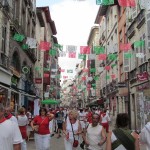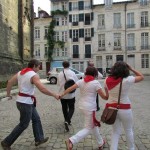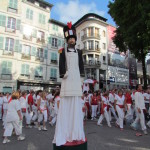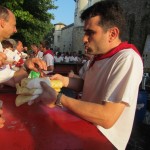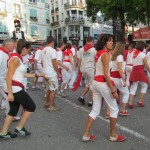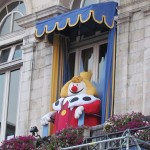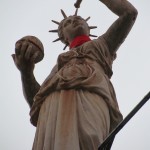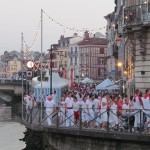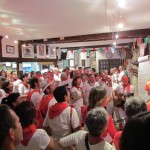Le Fetes de Bayonne - Day 2
Yesterday I experienced the true Basque culture that is featured here at the Fetes de Bayonne. Elisa and Ama Mikela (ama means mamma in Basque) took me and few other friends to the traditional part of the festival which happens slightly earlier in the evening. Ama Mikela was our tour guide, leading us through the tiny streets of Bayonne, first in the Grand Bayonne section. The river Adour splits the city in two, Grand Bayonne and Petit Bayonne (the name has nothing to do with the size – big and small – it refers to the old Bayonne and the young Bayonne, sections more particular to the aforementioned age groups in the city!). As we were approaching the famous gothic Cathedral of Sainta Marie in the center of the city, we ran into a few street musicians and decided to follow them as they circled the holy place in song. The streets were filled with white, red, and green colors, the markings associated with le fetes as well as the Bayonne flag. Quickly we could see more and more people filing in to get ready for the evening.
We arrived at Place Jacques-Portes, a main square where the traditional music, singing and dancing were about to commence. Geants or giants were placed throughout the square, tall figures representing characters in the Basque mythology, and huge groups of people dance in circles around the giants. I decided to jump in and try a dance myself. Every song had a different dance, and every dance was almost completely different from the one prior; but I was determined to try and learn! With some help from Ama Mikela and other dancers around me, you can see I got the basic step of the mutti koak, literally translated to “the men’s” in Basque. It is a dance with the band leader giving direction for each step, almost like American square dancing, however you do not dance with a partner. This is where the giants serve a purpose and act at the center point of the circle, a marking point for the dancers to move around. Eventually I caught on to the more advanced turns after a few missteps!
As more people filled the square, other dances that resembled a more Spanish style of dancing were performed, and you can see how small and hoppy the steps are just by watching the arms and heads of the dancers bobbing up and down.
This went on for another hour – everyone knew every step of each dance. There must have been a variety of about six or seven different types, and by no means are they simple. One dance that I tried was about 12 minutes long, consisting of five different sections where each section was a different piece of music, different tempo, different dance. This was a partner dance, and Ama Mikela was a very patient partner, merci Ama Mikela! With all of that dancing, we worked up quite an appetite – stands selling taloa, a crepe/pita type bread with fatty bacon that is grilled wrapped inside (a typical Basque dish). Unbelievable; so simple yet so delicious! The local volunteers set up stands and were selling the taloa with cidre or cider. This cidre is not at all similar in taste to the usual cidre alcohol – it is quite tart, made with very little sugar, almost vinegary, but extremely tasty and refreshing (another Basque specialty).
As we ate, the band grew larger and little books with Basque lyrics to traditional songs were handed out – the band began to play and there was a full square of singing people!
We then decided to head to Petit Bayonne and as we crossed the river, we passed the Town Hall where a blow-up figure of King Leon was sitting on a balcony, overlooking the people of the city. Even the regal statues lining the top of the Bayonne Town Hall were wearing red fulars in celebration. More and more people were arriving, the streets just shades of white and red, walking in lines to bars and peñas, “caves” that originally were the stalls for the animals in the lower levels of the houses in the town. Now, the peñas are run by local associations and celebrate le fetes by opening their doors to the public and singing, drinking and eating with the people that come and visit. Here, the Peña Los Tilholes is one of the oldest peñas in all of Bayonne – it is actually an Occitania group (Bayonne consists of two ancient groups of people, the Basque and the Occitania, both with very mysterious origins). Los Tilholes were known as the men who would drive the long boats in ancient Bayonne, much like a gondolier.
As we left Bayonne, the night time drinking and bar hopping was just commencing, most definitely to continue until the sun came up this morning!

